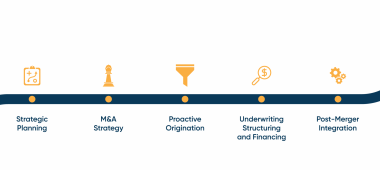This article was originally published in Forbes.
If the past two years have taught us anything, it’s that businesses must be quick to adapt to new and fast-changing market conditions. Based on recent developments, this likely means preparing for an environment that is different than the low-inflation, low-rate one that existed prior to Covid-19. Businesses, especially small and middle market companies with limited resources at their disposal, will need to reorient strategies and operations toward the challenges of an economy where prices for goods, services, and labor are trending relentlessly higher.
There are many reasons to believe that inflation is poised for a comeback, most notably because upward price pressures don’t seem limited to certain areas of the economy. Aside from the Labor Department’s headline consumer price index, which was up 5.3% year-on-year (YoY) in August—only marginally below the prior two months’ multi-decade peaks—we’ve seen strong increases elsewhere. This includes the more than 30% YoY gain (through mid-September) in the Bloomberg Commodity Price Index, which is near its highest level in more than five years. The S&P/Case-Shiller U.S. National Home Price Index, up 19.1% YoY in June, also keeps hitting new records.
Wage rates, historically a precursor of moves in inflation, have also been moving higher. The Atlanta Federal Reserve Bank’s Wage Growth Tracker, derived from the three-month moving average of the median growth rate of hourly wages, was up 3.9% YoY in August is within earshot of decade-plus highs. The Labor Department’s JOLTS index, which recorded its fifth straight month of record-high job availability in July, is signaling more upside pressure to come. Anecdotally, I polled almost two dozen business owners and professionals, and all noted how difficult it was to find workers, citing the need to offer signing bonuses and wages up to 20% higher than pre-pandemic figures.
Finally, inflation expectations are also increasing, which, as the Wall Street Journal recently noted, are often self-fulfilling. According to a survey by the New York Fed, consumers’ median expectation for inflation three years out climbed to their highest level in its history. Similarly, in a recent Citigroup survey, around 60% of survey participants are preparing for persistent inflation versus only 23% who believe it to be temporary due supply-chain disruptions and other pandemic-related factors.
But even if things return to “normal,” history suggests the economic risks remain to the downside. Given the length and breadth of the pandemic, the accompanying fallout likely represents a “shock” that will reverberate for some time. Moreover, the cycle of subdued inflation and declining interest rates in place prior to the crisis was noticeably overextended. Factor in unprecedented monetary and fiscal stimulus that has been pumped into the economy since early-2020, and it seems a good bet that the inflationary floodgates will eventually give way at some point.
Staying on track
Under the circumstances, CEOs, CFOs, and other managers will almost certainly need to approach things differently than they might have before the pandemic. Management and staff will have to account for conditions and considerations that many might not have previously considered, let alone lived through, including rising input costs and an increasingly tight financing environment. To meet these various challenges, here are five strategies worth considering:
1. Reevaluate and reorient strategies and processes. If ever there was a time to have a solid handle on the business, it’s now, when conditions are changing and operational nimbleness is essential. Ideally, managers will want to be fully aware about how rising costs and higher rates can impact their bottom line and will need to have business and market monitoring systems tuned as close as possible to real-time developments.
2. Keep pricing on the right track. Many businesses are hesitant to raise prices too often or too proactively, concerned about pushback from customers and whether it will disadvantage them relative to competitors. While that makes sense in an environment where the risk of inflation seems low, it can wreak havoc on margins and the sustainability of operations when broader price pressures remain persistent. Jeff Harmening, CEO of General Mills said “ideally you’d not like to go back to retailers multiple times with price increases, but we’re clearly not in an ideal market and people understand the need to revise plans.”
3. Optimize buying strategies. The correct mindset when inflation is rising is to buy sooner rather than later and lock in attractive prices whenever possible, especially in the case of a manufacturing or distribution business. Whether this means using hedging mechanisms such as the futures markets, expanding supplier networks to increase bargaining power, or agreeing to long-term contracts or creative structures with vendors, the goal is to shift the risk of rising prices elsewhere.
4. Cut costs and streamline operations. One way that businesses have historically dealt with rising inflation is to aggressively manage expenses, including figuring out creative ways to rework labor- and material-intensive operations. This might range from rethinking logistics and packaging, to consolidating different segments and operations, to targeting more productive approaches to creating, distributing, and marketing goods and services.
5. Transform debt into a strategic asset. While they don’t always move in lockstep, interest rates, especially for longer-term obligations, tend to track inflation. One way to capitalize on this is to evaluate the capital structure of the business and restructure and/or refinance debt. More aggressive options include acquiring capital equipment or other assets critical to your business—the prices of which are expected to keep pace with inflation—today and financing them with fixed-rate debt.















